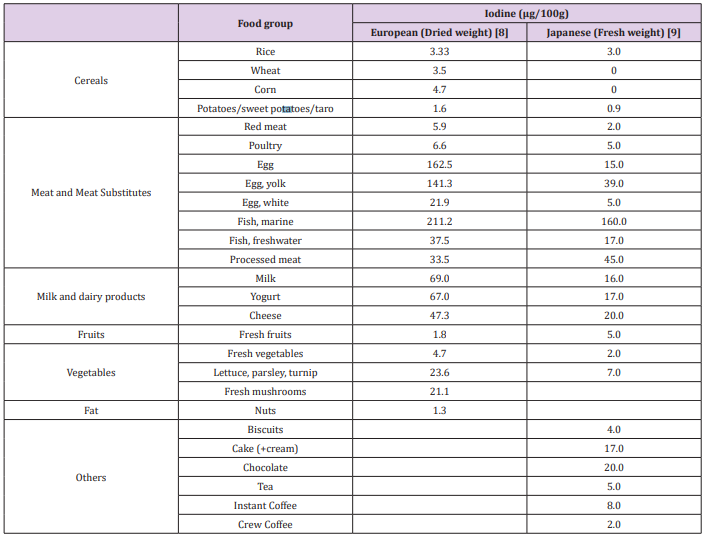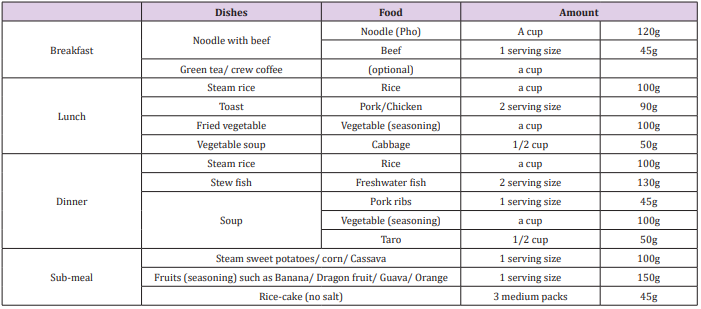Low Iodine Diet for Postoperative Patients with Thyroid Cancer in Vietnam
Introduction
Thyroid cancer is the most common malignancy of the endocrine system [1,2]. It is accounted for 5% of all cancers diagnosed each year in female and the number is expected to rise [2,3]. The postoperative administration of I-131, also called ‘ablation’ is one of the benefits required therapy for differentiated thyroid cancer (DTC) patients [4]. The main objectives of ablation are to destroy remaining healthy thyroid cells, to treat remaining cancer tissue, and to recognize and prevent recurrences on patients who have undergone a total thyroidectomy [2,4-6]. The combination of RAI ablation and thyroid hormone has an effective treatment for patients and may reduce long-term cancer recurrence, decrease the prevalence of mortality, and contribute significantly to patients’ life expectancy [5]. Thyroid tissue is the place where stored both iodine and radioiodine with the Sodium-Iodide Symporter [6]. However, the DTC tissue has a symptom of Sodium-Iodide Symporter deficiency, hence the rate of I-131 absorption at the DTC is lower than the healthy thyroid [7,8]. For this reason, a low-iodine diet for one or two weeks is required before RAI therapy to increase its efficacy in DTC patients after total thyroidectomy. Most guidelines recommend limiting dietary iodine intake to 50µg daily for one to two weeks.
There are several types of research showed that LID could be a source of anxiety because the patients feel they are restricted in eating, the variety of food is limited, and they are confused about how much of food could be eaten. The review on Development of the database on iodine in foods and dietary supplements in 2018 showed that currently, iodine content data were available in the national food composition database of several countries. Vietnam is one of the nations, which the national databases have not contained iodine value [9]. In this review, we showed a summary of researches related to the regulars in low iodine diet as well as providing a list of low iodine food and quantity of each food which is familiar and suitable for Vietnamese.
Materials and Methods
We searched the keywords in English ‘low iodine diet’, ‘radioactive iodine’ and ‘thyroid cancer’ on Medical Science and PubMed website on 27th July 2018. There were 20 papers that were published from 2010. However, because of the requirement in the number of references from the Journal, we selected 13 nearest papers (2011-2018). Two papers were excluded because they were not published in English (Japanese, Korean). Two guidelines from United State and United Kingdom Thyroid association were included. An article from 2005 [8] and the Tables of Food Composition in Japan (2015) [9] were included as references for the iodine content of food groups. A research in Vietnamese were included to show the evidence of using I-131 in post-surgical differentiated thyroid cancer patients in Vietnam [10].
Discussion
Based on a review of the Nutrition situation in Vietnam from 2009 to 2010, the coverage of households used iodized salt with the iodine level equal to or larger than 15ppm in Vietnam was less than 70% [11]. Currently, Vietnam is one of 19 countries in the world is in an alarm of iodine deficiency status. American Thyroid Association recommends using I-131 for DTC treatment when urine iodine level is less than 15µg/dl treatment [10,12,13]. According to a 2013 study in Vietnam, the average urine iodine level of DTC patients was 12.7 ± 8.3µg/dl. Therefore, patients are required to implement lowiodine diet (LID) to meet the treatment standard. Results from that study also showed significant decrease in urine iodine level after 2 weeks of LID (6.1 ± 3.96µg/dl) [10]. Iodine is a key mineral which is essential in producing thyroid hormones. It is also common in many types of food. By cutting down on iodine in your diet, the body levels of iodine will be low, and the thyroid gland will send signals to get more iodine. When the patients take a dose of I-131, the thyroid tissue will absorb the radiation iodine more effectively. This will help making the treatment to work better and the test for radiation will be more accurate. The first reference in the literature advising the implementation of a LID prior to I-131 therapy was in 1975. The list of iodine content in food groups was published in 2005. The articles related to the low-iodine diet recommended a variety of food groups depend on the study time and areas.
However, all of them suggested restriction of all kinds of seafood, milk and dairy products, instant food or commercial products (dressing, packaged rice…) [5,14-17]. In this article, most of the guidelines on low iodine diet were updated by Korean researches from 2012 to 2016 [14,15] and the newest guideline from United Kingdom (2018) [18]. The American Thyroid Association and British Thyroid Association recommended less than 50µg/day of dietary iodine in 1 to 2 weeks. These associations also provide the number of serving size in their guidelines of LID [5,19]. The concentration levels of iodine in dry matter of food are summarized in Table 1. These data were subtracted from European studies. Table 2 summaries the guideline of low iodine diet with the number of servings per day with the list of food familiar to Vietnamese. A lowiodine diet 1 or 2 weeks before getting doses of radioactive iodine is recommended in most of the studies and guidelines [5,14-16,20]. There was a little to no effect from longer or shorter dietary length of LID. Timing is an important factor because the iodine contents can be changed by areas and individual eating habits [5,15,20]. Moreover, it was affected by patient’s implementation of the lowiodine diet [15]. Low iodine diet for one week can be enough for adequate preparation of RAI if the DTC patients were given intense education and improved accessibility to medical staffs or dietitians [5,7,15].
Hyponatremia was the main side effect that was reported to be in association with a low iodine diet and radioactive iodine therapy. The incidence of severe hyponatremia on LID was low in current studies. Several case reports showed that high-risk factors of hyponatremia were age greater than 65 years, elderly females, and patients use thiazide diuretics [3,16]. The restricted regular intake of LID may cause stress, anxiety for patients and taking more time of health staffs in the implementation period [15,19]. The patients often reduce their dietary salt intake along the LID period which could lead to complications. For these reasons, the patients should be guided carefully with a short, accurate and concise instruction of low-iodine dietary intake, as well as adequate salt intake during LID [21].
Conclusion
The low-iodine diet was recommended that the dietary iodine intake was lower than 50µg per day. The optimum time of a LID was one to two weeks. The general instructions of restricted iodine diet:
a. Restricted all type of seaweed and seafood.
b. The freshwater food is acceptable.
c. The maximum amount of consumption of meat (beef, pork, chicken) and freshwater food is 300g per day;
d. The maximum amount of consumption of grains (rice) is 300g per day
e. The maximum amount of consumption of fruits and vegetables is 400g per day. A sample of low-iodine diet menu for Vietnamese was showed on Table 3.
Table 3: Low-Iodine Diet menu for Vietnamese.
*The nutritional value was calculated based on Vietnamese Food Composition Table [21]: Energy (1700kcal); Protein (68g); Fat (48g); Carbohydrate (250g); Fiber (14.8);
** Estimated Iodine intake was calculated based on Table 2: 47.9µg.
The LID instructions in this paper were referred from the food composition databases that include iodine from the other countries. Development of databases on Iodine in foods is important to characterize main sources of dietary iodine, and databases on the iodine content of major dietary contributors provide a key information resource. Based on the national databases, we can standardize the guideline of low-iodine dietary for Vietnamese.
For more Articles: https://biomedres01.blogspot.com/





No comments:
Post a Comment
Note: Only a member of this blog may post a comment.